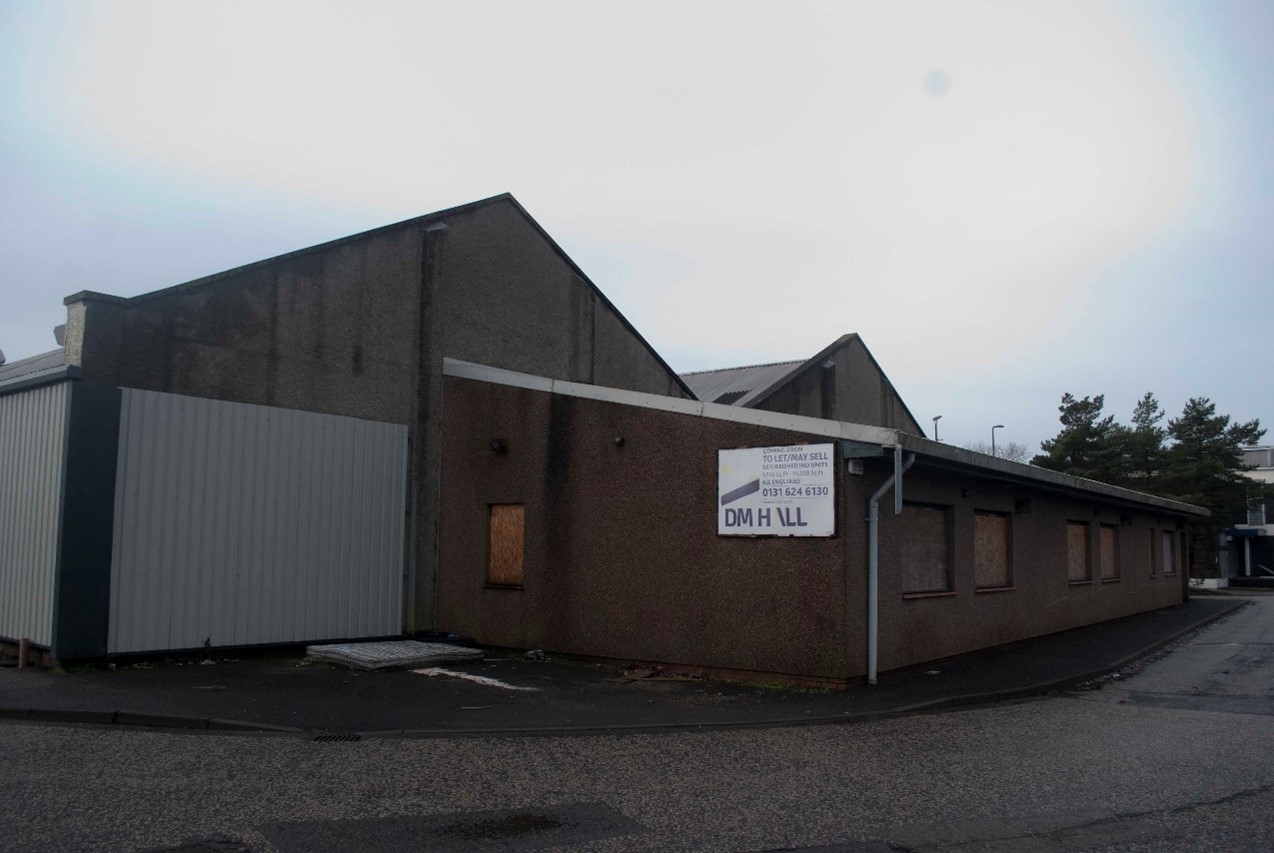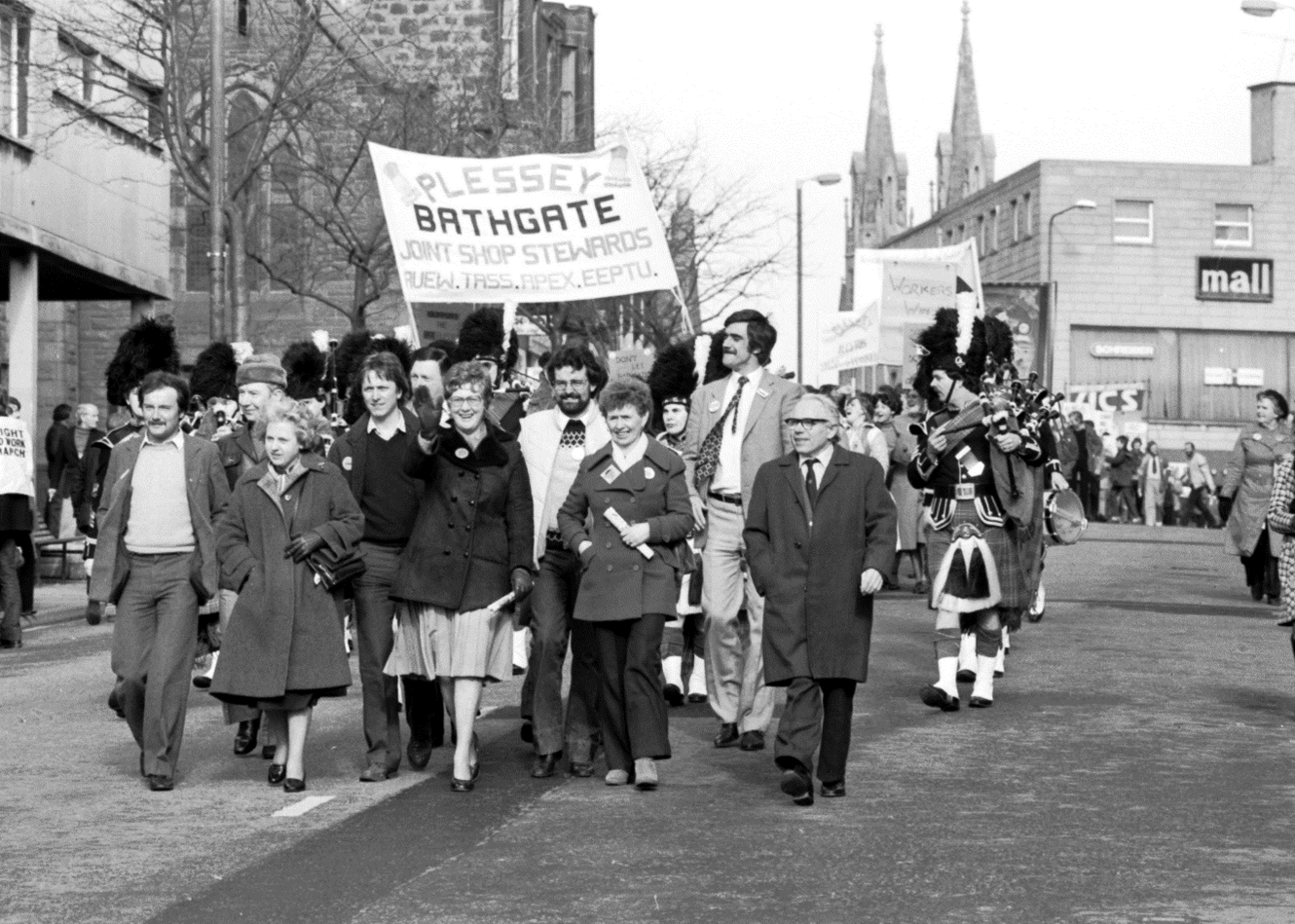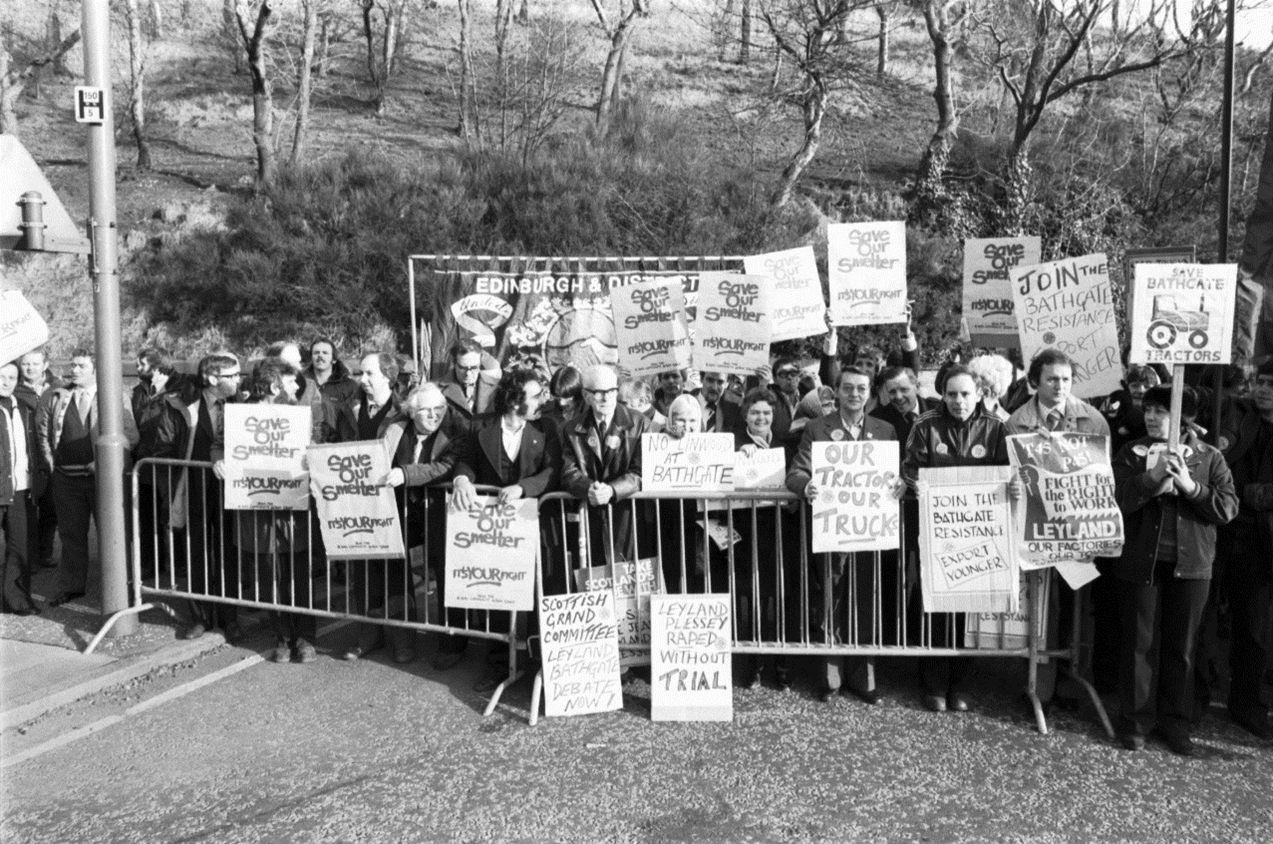Find out more about The Open University's Social Sciences courses
This article belongs to the Women and Workplace Struggles: Scotland 1900-2022 collection.

In
December 1981, the Plessey Company announced plans to shut down their
Capacitors plant in Bathgate. The factory – which employed predominantly women
assembly workers – had been downsized substantially throughout the 1970s.
Despite this, the decision to cease operations completely stunned the remaining
workers. In the weeks following this announcement the workers – led by shop
steward Ina Scott – met to discuss their thoughts and perspectives. They became
increasingly convinced that corporate greed was the crucial factor that
rendered them redundant. In January 1982, they launched an occupation of the
factory in an attempt to force Plessey to reconsider. In this piece, I outline
the history of Bathgate, the Plessey plant and, through incorporating oral
history interviews I conducted in 2015 and 2016, analyse the roots of worker
mobilisation. I then examine the dispute, and in particular Plessey’s legal
response and the landmark victory achieved by the workers at the Court of
Session in Edinburgh.
Background: Bathgate and Plessey
The town of Bathgate in West Lothian lies approximately 18 miles to the west of Edinburgh. From the industrial revolution, shale and coal mining dominated the local economy. Evidence of this past is still inscribed on the landscape, not least in the shape of the shale ‘bings’ which are dotted around the district. These can only be found in West Lothian and a group of 5 bings, known as the Five Sisters, are now registered as a protected industrial monument.
By 1954, half of the town’s workforce were employed in these two industries. The dominance of mining meant that there was not a significant manufacturing sector in the town; only one in ten workers were in manufacturing during the 1950s, one-third of the Scottish average.
There was a sharp decline in mining in the 1950s and 1960s, leading to many miners being laid off as the industry struggled to compete. However, in the early 1960s, the town of Bathgate, and West Lothian more widely, was not viewed as an area struggling economically. Rather, it was a ‘county on the move’, spearheading Scotland’s ‘new industrial revolution’, with modern industries envisaged to replace the declining traditional sectors of mining, textiles and shipbuilding (Clark, 2021). This optimism was due to the opening of a British Motor Corporation (BMC) plant in 1960, and the takeover of the Telegraph Condenser Company (TCC) by Plessey Capacitors in 1965.
Plessey began as a jig-and-tool manufacturer in London in the early twentieth century. Throughout the post-Second World War, the company expanded substantially through acquisitions and mergers, including the British Ericsson Telephone Company, Automatic Telephone & Electric, the Instrument Manufacturing Corporation of South Africa. In 1965, they took over the TCC, which had operated in Bathgate since 1947. The factory produced capacitors for a range of electronic devices and, as was common in the period, had a strict gendered division of labour; men worked in managerial and ‘skilled’ engineering, with women based in production assembly (for more, see McIvor, 2014). At the factory’s peak, 75 per cent of all workers were women working in assembly.

For Let / May Sell: An uncared-for building that was part of the Plessey Complex – now the Whiteside Industrial Estate. Image by Thomas Smillie Photography, January 2022.
Plessey: From Growth to Decline
Despite the significant growth of Plessey in this period, profit levels remained stagnant, leading to a mass restructuring programme during the 1970s. A key aspect of this was through cutting the global workforce, with an overall loss of 25,000 jobs, as they sought to ‘eliminate the loss leaders which no longer had a place in the industrial logic of Plessey’ (Plessey Chairman Sir John Clark, cited in Maxwell, 1983). The programme was hugely successful for Plessey’s shareholders, with their pre-tax profits doubling to £84 million between 1978 and 1980-81. For many, however, the programme led to redundancy and unemployment. Plessey’s UK workforce suffered greatest, with almost 20,000 jobs lost, representing 35 per cent of their total. These restructures had a devastating impact on Bathgate. Total employment declined from 2,400 in 1973 to 330 in 1981, a decrease of 86 per cent. By this point, worker Mamie Friel remembers that the factory was ‘just a skeleton’ of what it had been before. Despite the extensive downsizing, there was no indication that the future of the plant was in doubt. However, in December 1981, Plessey announced that the Bathgate site would close in March 1982. The remaining workers were stunned. In our oral history interview, worker Esther McGinnis described the closure announcement as ‘devastatin’ news… just unbelievable… we wur aw’ devastated at the final meetin’ that said Plessey was closin’, eh, aw, just couldn’t believe it’.
The Bathgate Occupations
This announcement didn’t lead to immediate occupation, as the workers – led by Amalgamated Union of Engineering Workers (AEU) shop steward Ina Scott – contemplated the options available to them. The company insisted that the capacitor market in the UK was ‘flooded’ and that their operations in Bathgate had never been profitable, and had lost £500,000 a year since they took over the TCC in 1965. However, as they entered 1982 and before launching occupation, the workers and their union representatives increasingly rejected the reasons given by Plessey for the plant’s closure. They argued that Bathgate had been systematically discriminated against, with structural disinvestment deployed to justify their decision.
The figures that were used to demonstrate that the factory was inefficient also came under close scrutiny. Incredulously, for the workers, the losses forecast for the factory included the provision for redundancy payments and other costs associated with leaving the site. Thus, the anticipated losses at the Bathgate plant were inclusive of the costs of closing the Bathgate plant, which the company had justified by the losses at the Bathgate plant. However, the leverage remained with the company, and they were unwilling to discuss a change of course in the rationalisation of their UK operations.
The decision by the Plessey workers to occupy was fundamentally influenced by local developments. A month after closure was announced, the workers at the local auto plant (now British Leyland) launched an occupation to oppose rationalisation. Jim Swan, convenor of the Joint Shop Stewards Committee at Leyland, recalls that the day after their occupation began, he received a phone call from Ina Scott, who sang down the line that ‘anything you can do, I can do better’. The workers at Plessey had also decided that they would occupy to strengthen their case that closure was unjust. The announcement was sudden, and action began swiftly. Some of those not on shift were stunned to discover when they arrived for work that the plant was under worker control. Elizabeth Fairley, assembly worker at Plessey recalled that:
Folk went tae work that mornin’ and the gates were locked and everythin’, and they were aw staundin’ in a row and ye couldnae get in… we wur haein’ a sit-in and we ken’t nothin’ aboot it, and it wis us that wur daein’ it, ken?

Demonstration in support of the Plessey Occupation, March 1982.
The workers quickly became organised, and shop steward Ina Scott regularly spoke with Helen Monaghan – the shop steward who led the Lee Jeans sit-in In Greenock in 1981 – to get advice and insights into conducting a successful occupation. Workers were allocated into shifts, committees were set up to handle particular aspects of the dispute, and workers travelled to speak with others and collect funds. For the first few weeks, the Plessey sit-in followed the ‘traditional’ pattern for this form of industrial action in Scotland; they were barricaded in the plant and refused to leave until management agreed to negotiate and, hopefully for the workers, reverse their decision. This changed drastically, however, when the company attempted to utilise the legal system to end the dispute.
In Scots Law, a company would require an interdict served to every member of an occupation to prevent the continuation of their ‘unlawful’ behaviour. The cumbersome nature of this process meant that it had not been used by any organisation to force an end to an occupation. However, in 1982 there were two cases of an interdict being sought – at British Leyland, Bathgate and Plessey Capacitors, Bathgate.
Both injunctions sought were granted, with the Leyland workers obeying its terms and ending their occupation. The workers at Plessey, however, defied the court ruling and remained in the factory. As a result, every remaining occupier was summoned to appear at the Court of Session in Edinburgh. They were offered legal support from future Scottish Government Minister, Kenny MacAskill, who at the time was a lawyer with Edinburgh-based Levy McRae. He had been visiting the workers to offer support on behalf of the SNP, and recalled in our 2016 interview how the idea to use a legal loophole against the firm originated:
Ah remember chattin’ away to Jonathan Mitchell, now QC, who had said “aw naw, there’s a loophole in factory occupations”. And ah remember maself, ah went and spoke tae them [workers]… Ah, and said there was a way out of it… But to be fair, it wis Jonathan Mitchell that knew about the chance to use it.
This loophole was Section 13 of the Trade Union and Labour Relations Act 1974, with the argument put forward that the occupation was being ‘carried out in furtherance of a trade dispute’. At the hearing on 26 February, Lord Kincaid agreed with this legal interpretation and ‘held that the sit-in might be protected by the terms of section 13 of TULRA 1974, and was of the view that the balance of convenience lay with recall of the interdict’. The victory of the Plessey workers was huge news across Britain, with the decision appearing on the front pages of national newspapers including The Scotsman, The Glasgow Herald and the Morning Star. Labour MP, Tam Dalyell, reflected on the significance of the victory when writing an obituary for Ina Scott in The Independent in 2004:
Very few individuals in Britain can reasonably claim to have brought about single-handedly an alteration in the law of the land. But, this is precisely what a factory-worker grandmother achieved.
Buoyed by the result, the workers continued their occupation throughout February and early March. At this point, the firm Arcotronics had formally noted interest in purchasing the plant and the site. The workers rejected the first offer, before an improved offer that would safeguard 80 jobs for one year was accepted by a two-to-one vote on 15 March 1982.
Conclusion and Legacy
Although the occupation was a success in preventing the full closure of the site, the number of jobs lost meant that it wasn’t, and isn’t, reflected on as an outright victory and vindication in the same way as those at Lee and Lovable. However, the general objective of the occupation was met: the immediate closure and full compulsory redundancy did not go ahead as was stated in December 1981. By seizing control of the plant, and taking on Plessey in the court, the workers demonstrated that organised workers could oppose capital relocation and unjust workplace closure in deindustrialising Scotland.




Rate and Review
Rate this article
Review this article
Log into OpenLearn to leave reviews and join in the conversation.
Article reviews